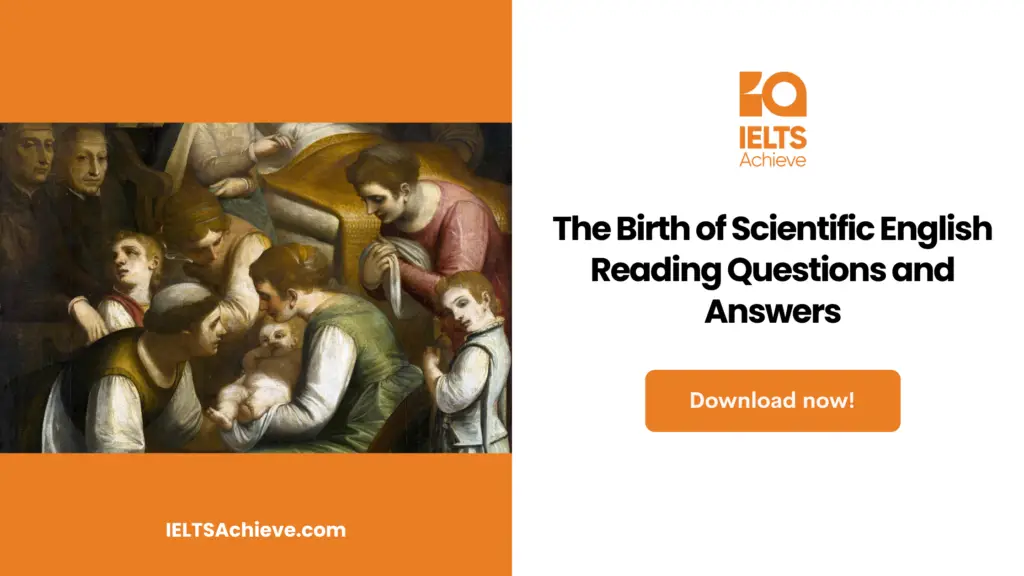The Blog post contains the following IELTS Reading Questions:
- IELTS Reading Note Completion
- IELTS Reading Locating Information
Stay informed and prepared for success – Explore our comprehensive Reading Test Info page to get valuable insights, exam format details, and expert tips for mastering the IELTS Reading section.
IELTS Reading Passage – The Birth of Scientific English

The Birth of Scientific English
A. In today’s world, science is based on a few languages including Japanese, French, and German, however, the English language is the one that is probably the widely-known global language of science. This fact is not due to the dominance of English-speaking countries like the USA in scientific research. But it’s the scientists from the non-English speaking countries thinking that they need to write their research in English to gain a global outreach. Because of the prominence of scientific English in the present world, it may look astonishing that nobody would know how to write science in English back in the 17th century. Previously, Latin was considered the lingua franca for European intellectuals.
B. The European Renaissance (c. 14th-16th century) also known as the `revival of learning, a period of refreshing interest pertaining to the ‘lost knowledge’ of ancient times. Meanwhile, many research scholars also started to do research and spread their knowledge and experience. During this time, the developed countries in Europe created an atmosphere to develop competitive interest in world exploration and to intensify trade. This form of expansion policy, that is to spread the English language to the west in the US and to the east in India, was ultimately welcomed by scientific developments like the innovation of magnetism (resulting in the invention of the compass). Similarly, developments in cartography and – in fact the most significant revolution in the scientific world is – the new facts and theories of astronomy along the rotation of the Earth from the various stars and planets, described by Copernicus between 1473 and 1543.
C. Amongst various countries, England was the first country to come forward and adopt the Copernican ideas, and published happily by their scientists. Some of the research scholars include John Wallis and John Wilkins, who were patrons of language, pioneered in the Royal Society in the year 1660 to establish an empirical approach in scientific research.
D. Similar forms of academies and societies emerged in other parts of Europe, setting a path to a new national tradition of science. In the starting time of this scientific revolution, almost all published work in the national languages were from popular works, encyclopaedias, language translations, academic textbooks and so on. There was no sign of science in the English language till the mid 17th century. If we see an example, Newton researched and published officially his mathematical treatise, called the Principa, in Latin. However, he later published research on the properties of light – Opticks in the English language.
E. Original science continued to write in Latin for various reasons. The major reason was to reach a wider audience. Since Latin was comfortable for international audiences consisting of research scholars, many choosed Latin. Whereas, English was emerging and spread to a socially wider population, more of the local community. Thus, popular science was developed in English.
F. The next best reason for preferring Latin, may be to maintain secrecy. Publishing openly and giving access to all might lead to some sort of danger. That is putting the research work into the public domain, where the initial ideas of the author did not reach its full potential. Besides above all, there was a rising concern about intellectual property rights during that time. It portrayed both the humanist intention of the individual, rational-thinking scientist who brings new inventions and discovers many things via private intellectual labour, followed by the rising attachment between original science and business exploitation. It is important to note that there was a social class distinction among scholars and gentlemen who could read, write, and understand Latin, and a pool of men of trade who didn’t know much Latin or lacked knowledge on classical texts. When we go back to the mid – 17th century, many mathematicians had a common practice that they do not disclose their discoveries and proofs outside. They did it by writing them in cipher, in some other languages, or else in secret messages kept in a sealed box with the Royal Society. On the other hand, some scientists preferred Latin for ease because of its audience. Even though it is open to international audiences, it was restricted socially.
G. The third reason for not writing the original science in English and being delayed may have been to work on the lack of linguistic capacity in English in the early modern era. Unlike other languages, English was not well prepared to face the argument based on scientific research. First, it did not have the technical vocabulary required for arguments. Second, it lacked the grammatical resources to represent the world and discuss the connections, like the cause and effect, that could come between complex and hypothetical entities.
H. Surprisingly, many members of the Royal Society showed a distinct interest in language and connected in various linguistic assignments. Some proposals came in the year 1664 to launch a committee for the purpose of developing the English language. The members of the Royal Society made several attempts, achieved a great deal to encourage the publication of science in English and encouraged the development of a convenient writing style. Besides that, some members also made publications on monographs in English. Amongst them, Robert Hooke was the first one. He was the first curator of experiments from the society who explained his experiments with the help of microscopes in Micrographia (1665). His entire work was based on narration style, an oral transcript and lectures.
I.A new scientific journal called ‘Philosophical Transactions’ was inaugurated in 1665. It is the first officially announced International English-language scientific journal that motivated a new form of scientific writing that highlighted the aspects of specific experiments. Hence, the 17th century is regarded as a starting stage for establishing the concept of scientific English. However, in the subsequent years, this momentum had gone in vain because the German language took the lead and became the leading European language of science. Before the beginning of the 19th century, it was evident that 401 German scientific journals were published compared to the 91 in France and 50 in England. Nevertheless, throughout the 19th century, the scientific English again flourished with the substantial growth of the lexical part as it supplemented the industrial revolution’s need for new technical vocabulary. It included new optimised societies filled with professionals in order to boost new disciplines and publish new research studies.
Unlock your full potential in the IELTS Reading section – Visit our IELTS Reading Practice Question Answer page now!
Recommended Questions:
Renewable Energy IELTS Reading Question with Answer
The Birth of Scientific English Reading Questions
Questions 1 – 7
Complete the notes below.
Write NO MORE THAN THREE WORDS AND/OR A NUMBER from the passage for each answer.
- proposals came in the year 1664 to launch a committee for the purpose of developing the 1. __________ .
- Many 2. ___________ had a common practice that they do not disclose their discoveries and proofs outside.
- Some of the research scholars include 3. ___________ and 4. ___________, who were patrons of language, pioneered in the Royal Society.
- Reason for not writing the original science in English and being delayed may have been to work on the lack of 5. ___________ .
- Besides that, some members also made publications on monographs in English. Amongst them, 6. ____________ was the first one.
- A new scientific journal called 7. _____________ was inaugurated in 1665.
Boost your performance in Summary, Notes, Table, and Flowchart Completion tasks. Click here to explore our detailed guide and learn how to effectively complete summaries, notes, tables, and flowcharts in the IELTS Reading section.
Questions 8 – 13
This reading passage has nine paragraphs, A – I. Write the correct letter, A – I as your answer to each question.
Note: You may use any letter more than once.
8. The Latin is used for maintaining secrecy.
9. The first International English-language scientific journal motivated a new form of scientific writing.
10. Developed nations in Europe created an atmosphere for competitive interest and trade.
11. England first came and adopted the Copernican ideas.
12. Latin was used to reach a wide audience.
13. During the 17th century, nobody knew how to write science in English.
Unlock your full potential in the IELTS Reading section – Visit our IELTS Reading Practice Question Answer page now!
Recommended Questions:
Renewable Energy IELTS Reading Question with Answer
The Birth of Scientific English Reading Answers
1. English language
2.Mathematicians
3. John Wallis
4. John Wilkins
5. Linguistic capacity
6. Robert Hooke
7. Philosophical Transactions
8. Paragraph F
9. Paragraph I
10.Paragraph B
11.Paragraph C
12.Paragraph E
13. Paragraph A

We hope you found this post useful in helping you to study for the IELTS Test. If you have any questions please let us know in the comments below or on the Facebook page.
The best way to keep up to date with posts like this is to like us on Facebook, then follow us on Instagram and Pinterest. If you need help preparing for the IELTS Test, join the IELTS Achieve Academy and see how we can assist you to achieve your desired band score. We offer an essay correction service, mock exams and online courses.

